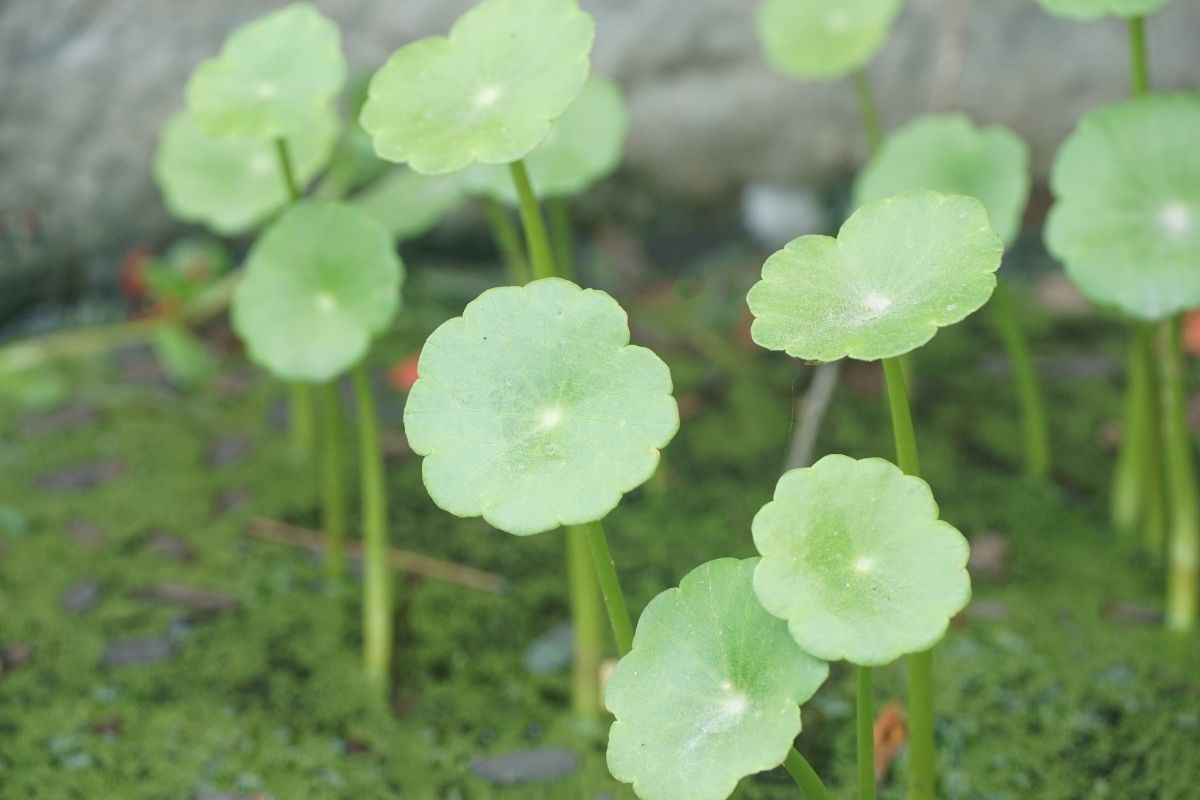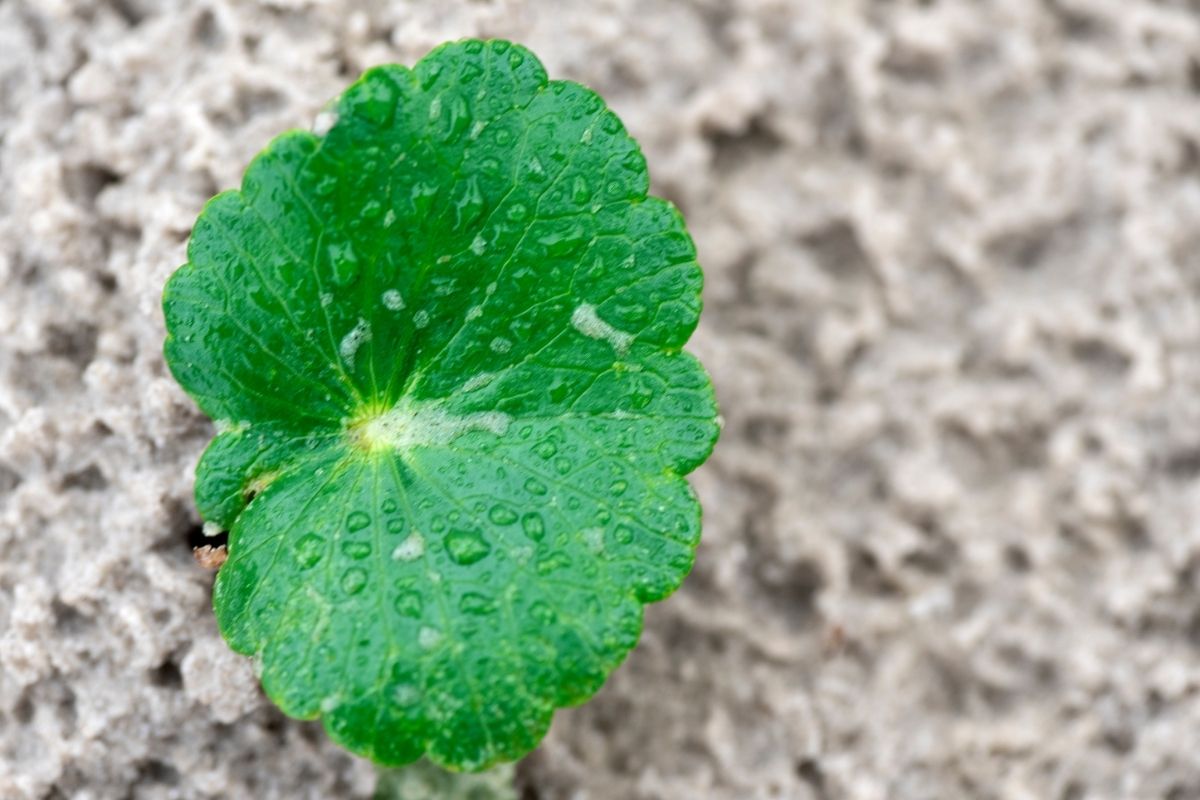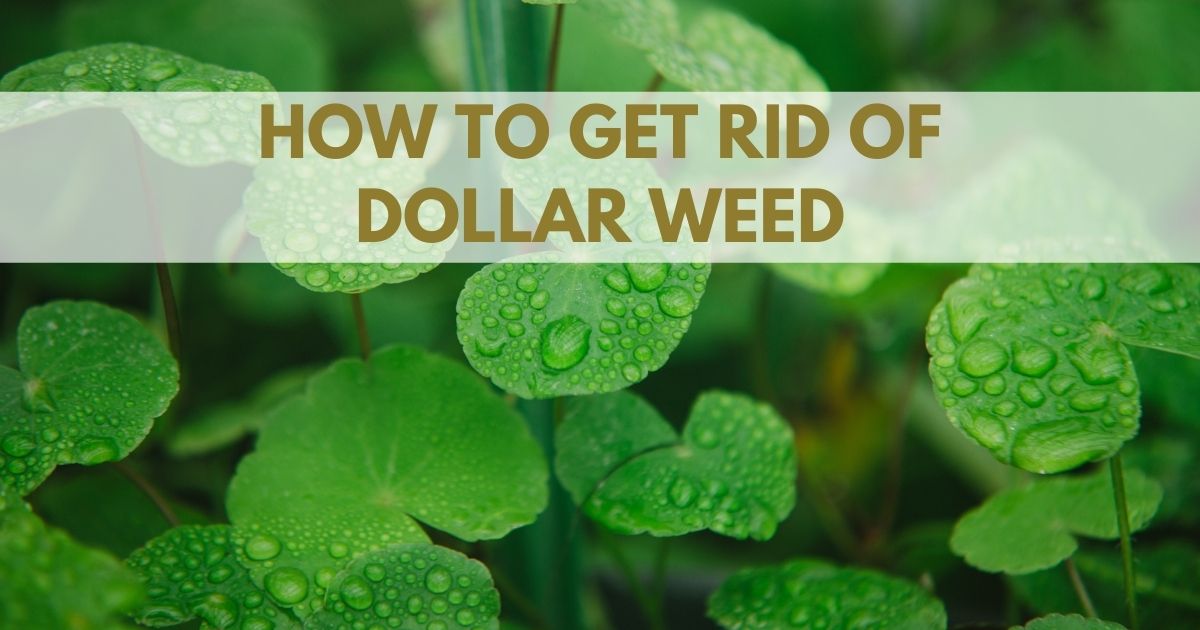What is Dollar Weed?
Dollar weed is a perennial weed with brilliant green, spherical leaves with wavy borders. From July to August, little white flowers bloom. How to get rid of dollar weed is the big question. The creeping stems take root wherever their nodes come into contact with the soil, increasing the number of plants.
Dollar weed flourishes in warm temperate regions of the United States, growing in damp, shady lawns, gardens, and unplanted spaces.

What Does Dollar Weed Look Like?
It’s critical to confirm that the weed in your lawn is dollar weed. Misidentification can lead to ineffective products and methods to remove them, wasting time and money.
- Dollar weed, sometimes known as lawn pennywort, is a perennial warm-season weed that derives its name from the form of its leaf, which resembles a silver dollar.
- Dollar weed is a dark green plant that looks like a bit of lily pad-looking weed.
- Dollar weed blooms in the summer, between July and August, with tiny white flowers.
- Dollar weed is frequently confused with dichondra, another weed. By examining their stems, you can tell the two different. Dollar weed branches are visible from the middle of the leaf, unlike dichondra stems, which you can see at the margin of the leaf.
- Dollar weed is a plant that thrives in water and may float.
- It’s usually a sign of excessive moisture levels in the turf when you observe it in St. Augustine grass.
- Dollar weed’s creeping stems root anywhere their nodes come into contact with the soil, multiplying the number of weeds in a short period.
Make sure the weeds in your lawn are dollar weeds by looking at the description and image above. If you’re not sure, get in touch with us to assist you with the correct identification.
How to Get Rid of Dollar Weed
Dollar weed flourishes in extremely damp places; thus, lowering moisture in the afflicted area with regular mowing and irrigation is the best approach to treat it. You should also address any drainage problems you may have.
Furthermore, you can readily pull up dollar weed by hand; however, this is time-consuming and may not be possible in bigger regions. Organic pest management entails a variety of approaches that may or may not work for you, but it’s always worth a shot before resorting to chemicals. The following are some of these methods:
- Boiling water: Pouring boiling water on dollar weed-infested areas will destroy the plants immediately. Boiling water can kill whatever it comes into contact with, so be careful not to get any on any surrounding plants or grass.
- Baking soda: Some individuals have successfully killed dollar weeds with baking soda. Soak the dollar weed leaf in water and add baking soda on top, then leave it to dry overnight. This is supposed to kill the weeds while leaving the grass unharmed.
- Sugar: Some people have had success sprinkling white sugar over cannabis. Spread the sugar evenly over the area and thoroughly wet it.
- White vinegar has also been effective as a dollar weed herbicide when used as a spot treatment.
How to Kill Dollar Weed with Chemicals
When it comes to killing dollar weeds, chemical management is sometimes required. Most dollar weed herbicides are sprayed in the spring when the plants are still young, but multiple applications may be necessary. Monument, Manor, Blade, Image, and Atrazine all have an identity as powerful weed killers.
You can also use them on grass like Zoysia, St. Augustine, Bermuda, and Centipede. Please make sure you pay attention to the directions they provide you. Chemical management should only be used as a last resort, as organic methods are far safer and environmentally beneficial.
We recommend using either herbicide with a 1-gallon (3.79-liter) pump sprayer for most common applications so you can easily make focused spot applications.
Step 1 – Measure the Area For Treatment
Calculate the square footage of the area you wish to treat before applying the product. Multiply the length and breadth to get the square footage (length x width = square footage). The amount of product you’ll need to combine with water will be determined.
The MSM turf herbicide mix rate is 0.5 to 1 ounce (14.17-28.34 grams) per acre. In a hose-end sprayer, mix 1 ounce (28.34 grams) of MSM grass herbicide with 16 ounces (453 grams) of water to treat a 2,000 square foot (185.81 square meters) area. You can use only 1 ounce (28.34 grams) of MSM grass herbicide in each solution.
If you need to treat an area of more than 2,500 square feet (232.25 square meters), you’ll need two different solutions containing 1 ounce (28.34 grams) of MSM grass herbicide. Use 6 to 12 ounces (170-340.19 grams) of product per acre for treatments with Fahrenheit.
Step 2 – Mix Herbicide
You can start making your solution after determining the amount of MSM turf herbicide you’ll need. Pour water into your pump sprayer, then add the measured amount of MSM turf herbicide. Fill the sprayer with water and agitate it until thoroughly mixed with the solution.
To make Fahrenheit, measure out the amount of product you’ll need with the measuring cup. To fill the measuring cup without spilling the product, just connect the mouth of the cup to the mouth of the bottle and turn the bottle upside down.
Step 3: Spray Dollar weed with Herbicide Solution
You can start spraying the area you wish to treat. Use the fan spray setting. Spray your lawn till it’s wet but not soggy.
Allow 24 hours between waterings to allow the product to absorb the weeds. In two weeks, you should see results. After 21 days, you may need to reapply.

Dollar Weed vs. Creeping Charlie– The Difference
Dollar weed leaves indent where they join the petiole, but Creeping Charlie leaves have ragged edges (leaf stem). The middle of their leaves connects to the leaf stem, not the border. Dollar weed leaves are spherical, brilliant green, meaty, and resemble little lily pads with a scalloped edge of about 1 to 2 inches (2.54 to 5.08 centimeters) in diameter.
It spreads through seeds, rhizomes, and tubers and has a low-growing habit. Dollar weed is frequently mistaken for dichondra. You can distinguish dollar weed by its umbrella-like leaves that attach to the petiole in the leaf’s center. Dollar weed gets its name from the spherical leaves about the size of a silver dollar. Its leaves are lustrous and dark green.
This broadleaf plant produces tiny white star-shaped flowers with five petals in the right conditions. On the other hand, these flowers rarely get a chance to bloom.
On the other hand, the following characteristics define Creeping Charlie: It has brilliant green foliage and grows low to the ground. It has scalloped margins on round or kidney-shaped leaves.
On a stem, these leaves grow in opposite directions and adhere to the branch at the leaf node. Blueish-purple funnel-shaped flowers bloom along the stem in the spring. When you crush creeping Charlie, it emits a minty scent.
Preventing Dollar Weeds From Growing
You want to make sure that dollar weed doesn’t come back after treating your lawn. Here are a few things you can do to defend your territory.
Spot Treat
If you have a few dollar weed plants, you can use a ready-to-use product to spot-treat them. Dollar weeds should not be pulled by hand if a bit of the root is left behind. The weed will regrow. After checking for dollar weed in your yard, you may begin treatment.
Before handling or applying any product, make sure you put on the appropriate personal protective equipment (PPE). You can efficiently control dollar weed with either MSM turf herbicide or Fahrenheit herbicide. MSM turf herbicide is a non-harmful herbicide for your lawn. It can cover up to one acre of turf.
This product can be applied using a hand pump, hose-end, or backpack sprayer. Fahrenheit is a water-soluble granule with a broader range of applications, and you may use it in large quantities, such as for area treatment.
Apply a Weed & Feed
Hold off on watering for two weeks to cure significant dollar weed infestations. Most grasses can withstand a brief period of drought, but dollar weed cannot. Instead, it deteriorates, making it a prime target for control products.
Following the package directions, apply a weed-and-feed product indicated for dollar weed, such as Scotts® Turf Builder Bonus® S Southern Weed & Feed or Scotts® Turf Builder® Southern Triple Action, after two weeks. These products will feed your grass, but they will also kill dollar weed.
Take Care of Your Lawn
Regular feedings with lawn fertilizer, such as Scotts® Turf Builder® Southern Grass Food, supply your lawn with the nutrients it needs to grow thick and strong, which will help it crowd out weeds like dollar weeds.
Less Water
Make sure your lawn doesn’t have too much water on it. You can avoid this by installing an irrigation system or aerating your soil. Dollar weed is a plant that thrives in water. If you have weeds on the lawn, the area is excessively damp.
Reduce watering until your grass receives only 1 inch (2.5 centimeters) of water per week, either from rainfall or irrigation, allowing the soil to dry out.
Dollar weed won’t be able to grow as well in the dry soil, but your grass will have deeper roots, allowing it to outcompete weeds more effectively. Improving your soil drainage to assist in reducing damp soil conditions will also aid in the suppression of future dollar weed outbreaks.
High Mow
Mowing your lawn at the appropriate height encourages it to grow thicker and build a deeper root structure. Because dollar weed thrives in thin grasses, strengthening your lawn is an excellent technique to keep it from resurfacing.
Make careful to mow at a good height, as turf with a short height is more vulnerable to weed invasion. The optimal mowing height for St. Augustine grass is 3 to 4 inches (7.62 to 10.16 centimeters). Bermuda lawns prefer a 1.5 to 2-inch (3.81 to 5.08-centimeter) height, whereas zoysiagrass and centipede lawns demand a 2 to 3-inch (5.08 to 7.62-centimeter) height.
How to Inspect for Dollar Weeds
Please look at your turf after correctly identifying dollar weed to see where it’s active. This will aid in determining where your herbicide application should be focused.
Where to Inspect
Look for high-moisture-content spots on your lawn. Dollar weed will thrive in areas with excessive moisture in the soil. This plant likes to grow in areas where your lawn is mowed too short.
What to Look For
You should avoid a weed that resembles a little lilypad. Glossy green leaves with wavy margins will be present. Most likely, dollar weed will be together in clusters.

Key Takeaways
Dollar weed flourishes in extremely damp environments; thus, the best way to cure it is to reduce moisture in the afflicted area through proper mowing and irrigation. You should address any drainage difficulties that may exist should.
You can also readily pull up dollar weed by hand; however, this is time-consuming and may not be possible in bigger regions. Organic control entails various techniques that may or may not work for certain people.
We believe this article helps you greatly with the best way to get rid of dollar weeds in flower beds. Besides, you are in an excellent position to understand how to kill dollar weed without killing grass.
